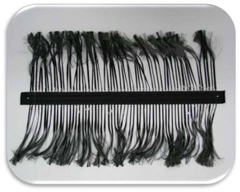Dr. Chaiyasit Kamthornkittikul, a Thai professional living in Japan, recently discussed the use of carbon fibers to treat wastewater at “The Thai Professionals Conference 2010: Green Thailand”, an academic conference jointly organised by the Reverse Brain Drain Project, the National Science and Technology Development Agency (NSTDA),
the Ministry of Science and Technology, the Office of the Higher Education Commission and the Thai Research Fund (TRF). Dr. Chaiyasit said that Japan is now experimenting with carbon fiber technology in water treatment usage. Carbon fiber has characteristics similar to cotton fiber and synthetic fiber, but it is composed mostly of carbon atoms. Carbon fibers now come in different pre-fabricated shapes, patterns and sizes, like balls or strips and are available commercially.

“The most important characteristic of carbon fiber is its ability to efficiently absorb other chemicals. When you put phosphorus compounds in water at a concentration of 20 mg/litre, then add carbon fibers and leave it for one day, you will find that the water is much clearer and the level of phosphorus has dropped to the normal level. Moreover, when comparing its absorption rate to the rates of other fibers, the carbon fiber’s performance surpasses other fibers’. Carbon fibers are able to reduce 2,474 cubic centimeters of contaminates in water to just 778 cubic centimeters within one day. Meanwhile, using cotton, nylon and polyethylene to treat polluted water for the same amount of time left the contaminate amount at 2,138 cubic centimeters, 2,262 cubic centimeters and 1,944 cubic centimeters, respectively.
“In addition, when experimenting by putting carbon fibers in a natural body of water, it was found that the carbon fiber was able to absorb and bind a large quantity of organisms. The process began with the carbon fibers absorbing nutrients and chemical compounds. After that, the plankton, small plants and water plants were bound with the carbon fibers. After, microorganisms like bacteria started to form and fish would start to lay eggs,” said Dr. Chaiyasit.
At the present time, carbon fibers are being used to treat wastewater in many ways, including putting carbon fibers directly into the water and inserting carbon fibers inside nets to prevent destruction by animals. In some experiments, carbon fibers were made into underwater buoys and the results showed that the water had become clearer and the water quality had improved significantly with increased oxygen levels. The carbon fibers also helped reduce the population of non-essential algae.
However, one important disadvantage of carbon fibers is its expensive price, selling at about 100 baht per metre. Thailand should conduct research into using coal composed with carbon, which may lead to a new wastewater treatment technology at a more reasonable price.
For more information, please contact:
The Reverse Brain Drain Project
The National Science and Technology Development Agency (NSTDA)
The Ministry of Science and Technology
Tel. 0 2564 7000 ext. 1446 through 1449
Fax. 0 2564 7004
E-mail: This email address is being protected from spambots. You need JavaScript enabled to view it.
